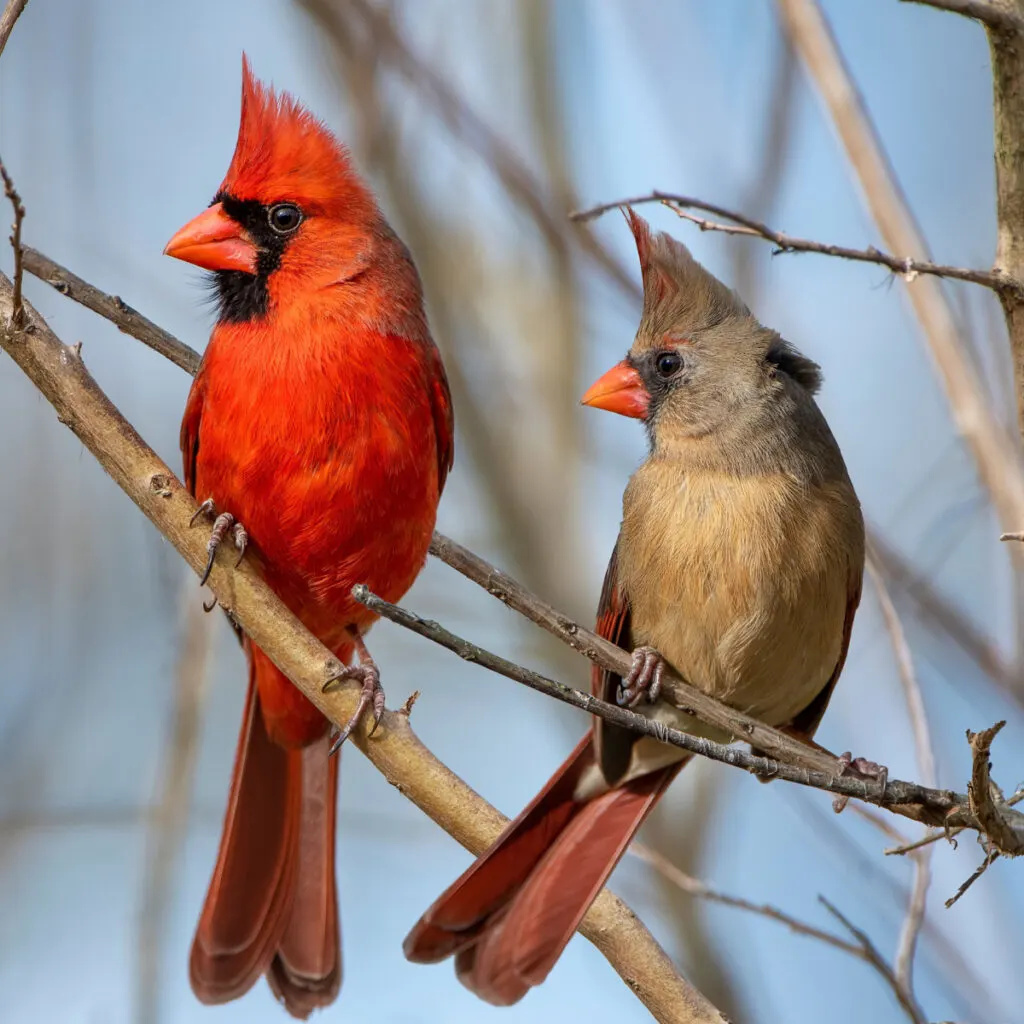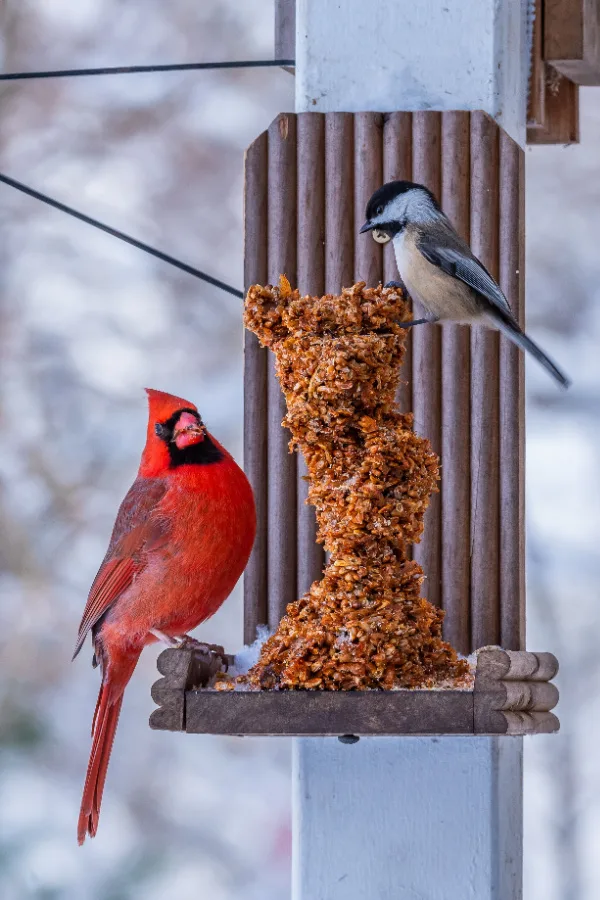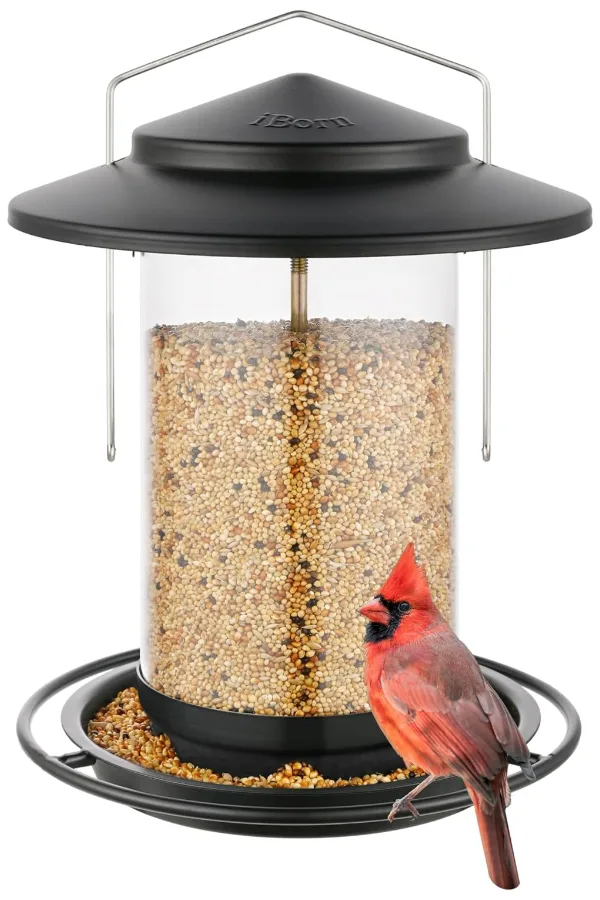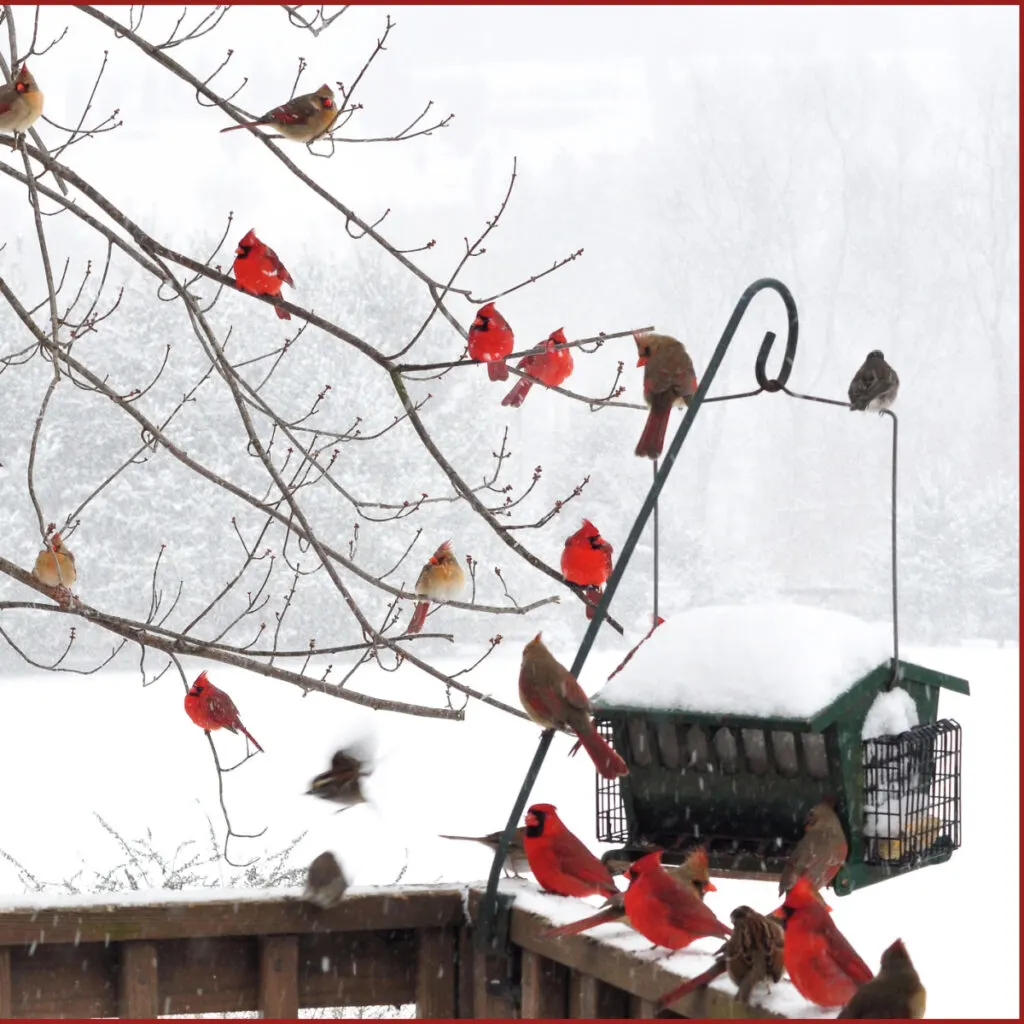Want to know how and what to feed the cardinals to attract them to your backyard this winter – and have them visiting your feeders more than ever?
There is nothing more beautiful than watching a cardinal flying about in the winter. Whether it be a bright red male or the pale, muted colors of a female cardinal, redbirds are one bird that really stand out in the bare backdrop of a winter landscape.
Unlike many other species of birds, cardinals do not migrate during the cold winter months. Instead, they stick it out, surviving by foraging for wild berries, nuts and seeds. All while seeking shelter and security in evergreen trees, shrubs, or wherever they can find protection from the cold, wind and snow.

But locating food can be difficult at times for cardinals. Especially in the winter when many of their typical food sources become scarce or completely disappear from the landscape. And a lack of food for a cardinal couldn’t come at a worse time during the winter.
The Need For Winter Calories – How To Feed Cardinals
Cardinals burn a tremendous amount of energy in the winter foraging for their food – and even more trying to stay warm overnight in frigid temperatures.
Unfortunately, these beautiful birds can’t store food for the winter season, which means they have to find their food on a daily basis. Not just for a meal to curb their hunger, but to have calories saved up to burn in order to warm their bodies and stay alive overnight.
It is for that very reason that feeding cardinals can not only bring bright color to your feeders and backyard – but help keep them safe, healthy and secure all winter long. The best part – it’s easy to do!
How To Attract Cardinals In The Winter
When To Feed
When it comes to feeding redbirds, it’s just as important to know when and how they like to feed as knowing what they like to eat. Put simply, when you meet all three of those needs on a consistent basis, cardinals will flock to your feeders!
For starters, cardinals are early and late feeders. They prefer to eat in the early morning and right before the sun goes down. Why? Because in the winter these two times are very critical when it comes to their health and survival overnight.

They need energy the first thing in the morning to replace what they burned overnight trying to stay warm. And at night – they are trying to build up reserves to heat their bodies as the temperatures drop.
With that in mind, it is important to make sure feeders are well stocked early in the morning and in late afternoon before sunset. Obviously, it’s great to have feed in at all times, but these are the most critical of all.
It’s also important to help cardinals out with a source of hydration. Cardinals still need water to survive – even in the middle of winter. In fact, they need it more than ever, as hydration is vital in helping them to stay warm as well. Unfortunately, in the winter, many of their sources for fresh water are covered or gone.
A small shallow pan of water placed on the ground near their feeder at feeding times can go a long way in keeping them coming back. Even if it freezes, they can still chip at the ice with their strong beaks to provide moisture.
Selecting The Best Feeders & Location – How To Attract & Feed Cardinals In The Winter
Using feeders cardinals like and placing it in a good location are both important as well. Cardinals are known to be front feeders. Which means they like to have their food in front of them with a bit of area to sit or perch.

For this reason, platform feeders are one of the best options when feeding cardinals, especially in the winter. It allows plenty of space for the cardinals to sit and enjoy their dinner, even when snow covers the ground below. Affiliate Link: Metal Bird Feeder for Outside Hanging,Wild Bird Feeders for Cardinal
Tube feeders and suet feeders are good choices as well. Both allow cardinals a perching location with the food source in front of them which is ideal for feeding. Last but not least, cardinals will feed from the ground as well when available. When filling your feeder, always leave a bit under the feeders to provide extra feeding space if too many visit at once.
Selecting The Right Location – How To Attract & Feed Cardinals
Finally, where you place your feeder can make a huge difference for the winter safety of cardinals. A cardinal’s red coat can be spotted easily, especially in the stark whiteness of winter. Unfortunately, that can make them easy prey for hungry hawks.
Locating feeders under the cover of a tree or near bushes and shrubs will provide them with natural protection from hawks or eagles. Again, if spreading food on the ground, under the cover of a tree is better than right out in the open.

Providing The Right Food Sources – How To Feed & Attract Cardinals In The Winter
So what are the best seeds and feed to give cardinals in the winter? The real key to success is to provide them with high fat, high calorie food.
Sunflower seeds, especially black-oil sunflower seeds fit that need perfectly. All sunflower seeds are highly nutritious and high in calories, making them great for feeding cardinals. But black oil sunflower seeds are by far the best of all.
Black oil sunflower seeds have a much higher oil content than regular striped sunflower seeds. And can they ever give cardinals (and other birds) plenty of nutrition that provide extra body heat to help handle the cold!
Next on the list for best seeds for cardinals are safflower seeds. They too are high in calories, nutrition and energy. Even better, squirrels and chipmunks can’t stand them – and often leave feeders with safflower seeds as part of the mix alone.
In addition to sunflower and safflower seeds, cardinals are also fond of cracked corn, peanuts, and dried berries. All provide excellent nutritional value for a balanced diet.

It’s certainly quite easy to create your own mix from the seeds and foods above. You can also find a large number of pre-mixed cardinal food blends in stores and on-line as well. Affiliate Link : Wagners Cardinal Blend Wild Bird Food
Last but not least, suet cakes, which are rendered fat filled with seeds are always great for feeding cardinals. Suet cakes provide high energy to a wide range of winter birds. They can truly be a difference maker when getting birds to keep coming back – and in helping them survive. See our article: How To Make Homemade Suet Cakes For Birds
Feed Consistently – How To Feed Cardinals In The Winter
If you want to attract and keep cardinals coming back, you need to feed consistently. Cardinals are creatures of habit – and if they find a consistent food source, they will visit on a regular basis. Even more, they will come to rely on it!
Although cardinals are usually territorial, in the winter, they often congregate to feed together. In fact, with good feed available, it is common to see 10 or more cardinals feeding at the same time. It can certainly make for a beautiful sight out of your kitchen or living room window!
Here is to feeding cardinals this winter and helping them survive the elements until spring arrives!
Follow Our Facebook Page For Great Gardening Tips And Advice! This Is My Garden Facebook Page
This Is My Garden is a garden website created by gardeners, for gardeners. Jim and Mary Competti have been writing gardening, DIY and recipe articles and books and speaking for over 15 years from their 46 acre Ohio farm. They publish three articles every week, 52 weeks a year. Sign up today to follow via email, or follow along!
